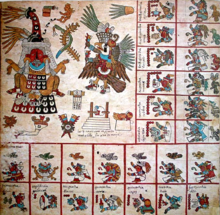- Codex Borbonicus
-
The original page 13 of the Codex Borbonicus, showing the 13th trecena of the Aztec sacred calendar. This 13th trecena was under the auspices of the goddess Tlazolteotl, who is shown on the upper left wearing a flayed skin, giving birth to Cinteotl. The 13 day-signs of this trecena, starting with 1 Earthquake, 2 Flint/Knife, 3 Rain, etc., are shown on the bottom row and the right column.

The Codex Borbonicus is an Aztec codex written by Aztec priests shortly before or after the Spanish conquest of Mexico. The codex is named after the Palais Bourbon in France. It is held at the Bibliothèque de l'Assemblée Nationale in Paris. In 2004 Maarten Jansen and Gabina Aurora Pérez Jiménez proposed that it be given the indigenous name Codex Cihuacoatl, after the goddess Cihuacoatl.[1]
The Codex Borbonicus is a single 46.5-foot (14.2 m) long sheet of amatl "paper". Although there were originally 40 accordion-folded pages, the first two and the last two pages are missing. Like all pre-Columbian codices, it was originally entirely pictorial in nature, although some Spanish descriptions were later added. There is dispute as to whether the Codex Borbonicus is pre-Columbian, as the calendar pictures all contain room above them for Spanish descriptions.
Codex Borbonicus can be divided into three sections:
The first section is one of the most intricate surviving divinatory calendars (or tonalamatl). Each page represents one of the 20 trecena (or 13-day periods), in the tonalpohualli (or 260-day year). Most of the page is taken up with a painting of the ruling deity or deities, with the remainder taken up with the 13 day-signs of the trecena and 13 other glyphs and deities.
With these 26 symbols, the priests were able to create horoscopes and divine the future. The first 18 pages of the codex (all that remain of the original 20) show considerably more wear than the last sections, very likely indicating that these pages were consulted more often.
The second section of the codex documents the Mesoamerican 52 year cycle, showing in order the dates of the first days of each of these 52 solar years. These days are correlated with the nine Lords of the Night.
The third section is focused on rituals and ceremonies, particularly those that end the 52-year cycle, when the "new fire" must be lit. This section is unfinished.
Contents
Notes
- ^ Jansen and Pérez Jiménez (2004, p.270).
References
- Jansen, Maarten; and Gabina Aurora Pérez Jiménez (2004). "Renaming the Mexican Codices". Ancient Mesoamerica 15 (2): pp.267–271. doi:10.1017/S0956536104040179. ISSN 0956-5361.
See also
External links
Categories:- Astrological texts
- Aztec codices
Wikimedia Foundation. 2010.

